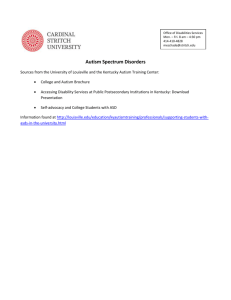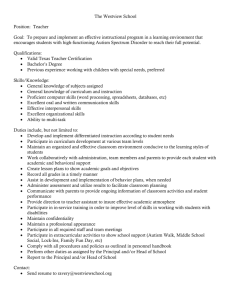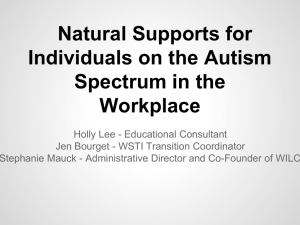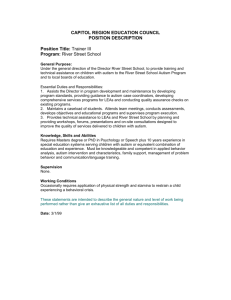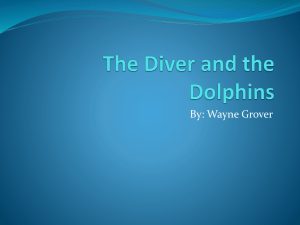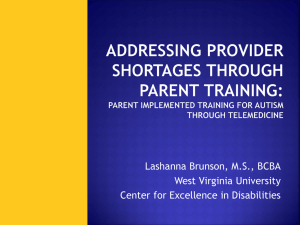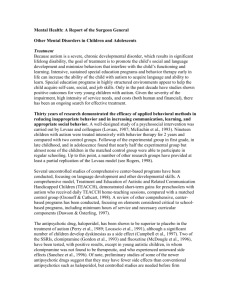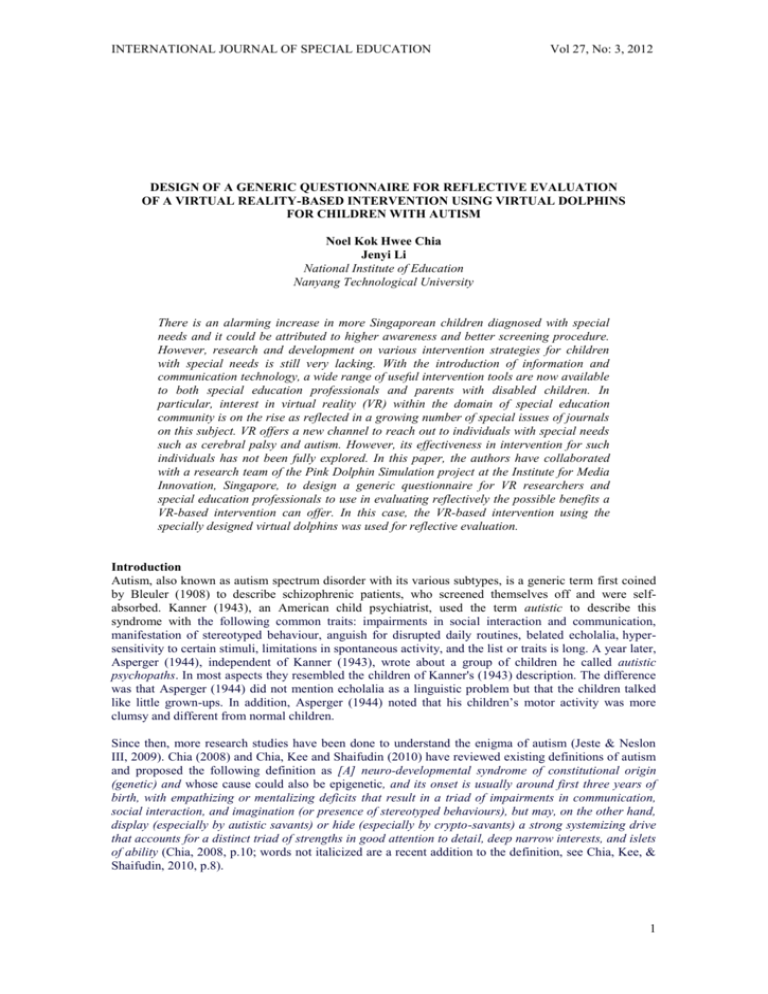
INTERNATIONAL JOURNAL OF SPECIAL EDUCATION
Vol 27, No: 3, 2012
DESIGN OF A GENERIC QUESTIONNAIRE FOR REFLECTIVE EVALUATION
OF A VIRTUAL REALITY-BASED INTERVENTION USING VIRTUAL DOLPHINS
FOR CHILDREN WITH AUTISM
Noel Kok Hwee Chia
Jenyi Li
National Institute of Education
Nanyang Technological University
There is an alarming increase in more Singaporean children diagnosed with special
needs and it could be attributed to higher awareness and better screening procedure.
However, research and development on various intervention strategies for children
with special needs is still very lacking. With the introduction of information and
communication technology, a wide range of useful intervention tools are now available
to both special education professionals and parents with disabled children. In
particular, interest in virtual reality (VR) within the domain of special education
community is on the rise as reflected in a growing number of special issues of journals
on this subject. VR offers a new channel to reach out to individuals with special needs
such as cerebral palsy and autism. However, its effectiveness in intervention for such
individuals has not been fully explored. In this paper, the authors have collaborated
with a research team of the Pink Dolphin Simulation project at the Institute for Media
Innovation, Singapore, to design a generic questionnaire for VR researchers and
special education professionals to use in evaluating reflectively the possible benefits a
VR-based intervention can offer. In this case, the VR-based intervention using the
specially designed virtual dolphins was used for reflective evaluation.
Introduction
Autism, also known as autism spectrum disorder with its various subtypes, is a generic term first coined
by Bleuler (1908) to describe schizophrenic patients, who screened themselves off and were selfabsorbed. Kanner (1943), an American child psychiatrist, used the term autistic to describe this
syndrome with the following common traits: impairments in social interaction and communication,
manifestation of stereotyped behaviour, anguish for disrupted daily routines, belated echolalia, hypersensitivity to certain stimuli, limitations in spontaneous activity, and the list or traits is long. A year later,
Asperger (1944), independent of Kanner (1943), wrote about a group of children he called autistic
psychopaths. In most aspects they resembled the children of Kanner's (1943) description. The difference
was that Asperger (1944) did not mention echolalia as a linguistic problem but that the children talked
like little grown-ups. In addition, Asperger (1944) noted that his children’s motor activity was more
clumsy and different from normal children.
Since then, more research studies have been done to understand the enigma of autism (Jeste & Neslon
III, 2009). Chia (2008) and Chia, Kee and Shaifudin (2010) have reviewed existing definitions of autism
and proposed the following definition as [A] neuro-developmental syndrome of constitutional origin
(genetic) and whose cause could also be epigenetic, and its onset is usually around first three years of
birth, with empathizing or mentalizing deficits that result in a triad of impairments in communication,
social interaction, and imagination (or presence of stereotyped behaviours), but may, on the other hand,
display (especially by autistic savants) or hide (especially by crypto-savants) a strong systemizing drive
that accounts for a distinct triad of strengths in good attention to detail, deep narrow interests, and islets
of ability (Chia, 2008, p.10; words not italicized are a recent addition to the definition, see Chia, Kee, &
Shaifudin, 2010, p.8).
1
INTERNATIONAL JOURNAL OF SPECIAL EDUCATION
Vol 27, No: 3, 2012
Recently, more media attention has been drawn on the alarming increase in diagnosed cases worldwide
of autism (Carpenter, Soorya, & Halpern, 2009; Lawrence & Karen, 2009; Poon, 2009) as well as in
Singapore (Kee & Loh, 2009; Lim, 2011; Tan, 2011). This increase in the number of children diagnosed
with autism could be attributed to higher awareness and better screening procedure (Chia, 2011, p.38).
However, the development of interventions and treatments for children with autism is still lagging behind
the advancement made in the design of better screening procedure and public education through talks,
forums and seminars for both professionals and parents. Today there are many so-called effective
strategies, such as facilitated communication, gluten-free/casein-free diet and chelation therapy, and
claims made about them with the promise that such approaches can help children with autism. It is
extremely important and timely to identify scientifically validated methods in order to provide an
effective early intervention program to young children with autism.
Simpson (2005) has classified the interventions and treatments for children and youth with autism into
five broad categories: (1) interpersonal relationship interventions and treatments; (2) skill-based
interventions and treatments; (3) cognitive interventions and treatments; (4) physiological, biological
and/or neurological interventions and treatments; and (5) other miscellaneous interventions and
treatments.
In this paper, the authors have chosen to focus on the dolphin-assisted therapy (DAT), which according
to Simpson (2005), falls under the category of interpersonal relationship interventions and treatments,
and then shifting to some form of computer-assisted intervention involving virtual reality (VR). The
dolphins, which are partially or indirectly involved in this study, have been raised in captivity in the
Dolphin Lagoon, Sentosa, managed by the Underwater World Singapore. The rationale behind this paper
is threefold: Firstly, it is to avoid using or relying on the real dolphins because of current ethical issues
arising from animal-assisted programs (Chandler, 2005; Iannuzzi & Rowan, 1991); secondly, it is also to
avoid being drawn into persistent protests from or any debate with pro-animal rights activists (Chua,
2011; Ho, 2011; Loi, 2011), especially from the Animal Concerns Research and Education Society (Lee,
2011); and thirdly, it is to evaluate the effectiveness of a VR-based intervention and in this case, the use
of virtual dolphins instead of real dolphins in the virtual dolphin-assisted therapy.
Dolphin-Assisted Therapy
There has always been something special about the dolphins. To the Minoans as far back as 1500 BCE,
dolphins are symbols of joy and music. The ancient Greeks even dedicated a temple at Delphi to a
dolphin god. This special relationship between humans and dolphins has gone beyond just religious
belief, moving into scientific and medical domains (Chia & Kee, 2010).
In the early 1970s, dolphins have been the subjects of interests in research investigation relating to the
understanding of effects of dolphin-human interaction on human behaviour. Dolphins have been trained
to assist individuals with disabilities, and this form of intervention approach became popularly known as
dolphin-assisted therapy (DAT). Several experimental studies (e.g., Humphries, 2003; Nathanson & de
Faria, 1993; Nathanson, 1998; Servais, 1999) have been done to investigate the effectiveness of DAT
with children with various disabilities, mental retardation, and autism. Cochrane and Callen (1992)
reported one study on how autistic children were relieved of their characteristic anxiety (e.g., vocal and
motor self-stimulations and rocking movement) and stress through positive interactions with dolphins,
and subsequently they also improved in their communication and learning. Another study reported that
DAT helped to motivate an autistic child to communicate (Smith, 1981).
In Singapore, Chia, Kee, Watanabe and Poh (2009) reported on the efficacy of DAT on reduction of
stereotyped behaviour in non-verbal children with autism and these subjects also began to hand-signal in
their attempt to communicate with others. In another study, Chia and Kee (2010) reported an increase in
self-awareness and self-regulation and all their five autistic subjects awarized – a term coined by the
researchers to refer to an action rather than to be aware of, a passive reaction (Chia & Kee, 2010, p.44).
There are many different forms of DAT. The simplest form can involve a child swimming with, touching
or taking care of dolphins, while the more complex one is based on an individualized structured program
designed to meet the needs of the child concerned. According to Nathanson (1998), the DAT is based on
the theory that children with disabilities will increase their attention to relevant stimuli in the
environment as a result of their desire to interact with dolphins. The general purpose of DAT is to
2
INTERNATIONAL JOURNAL OF SPECIAL EDUCATION
Vol 27, No: 3, 2012
encourage children with disabilities to engage to desired responses in accordance with their individual
education or therapy plan (Chia & Kee, 2010, p.43).
To date, there are mixed reactions regarding whether dolphin-assisted therapy actually benefits
individuals with autism or other disabilities. Apparently anecdotal reports from parents and those
working with dolphins and disabled people suggest that this intervention may be beneficial for some
individuals, especially in reducing stress and anxiety, alleviation of depression and pain prevention
(McKinney, Dustin, & Wolff, 2001). One possible reason why DAT works could be the primate
relationship an individual establishes emotionally with the nature (Verbeek & de Waal, 2002). Wilson
(1984) and Kellert and Wilson (1993) have termed this relationship as biophilia and described this as a
form of adaptive learning ability with rules that govern how one can learn about and from nature. It
involves emotional experiences ranging from attraction to aversion, from awe to indifference, and from
peacefulness to fear-driven anxiety (Wilson, 1993, p.31).
However, according to Cole (2009), holding a non-domesticated mammal captive to serve people is often
controversial. Those against this form of therapy often point to the limitations in the research, the often
exorbitant expense incurred by clients and family members, and the general welfare of the animals in
captivity (Beck & Katcher, 1996) (p.20). Researchers such as Humphries (2003) and Marino and
Lilienfeld (2007), who have reviewed DAT studies over the last decade, revealed inherent
methodological flaws in these studies resulting in unreliable outcomes. In other words, no conclusive
evidence has yet been found to suggest DAT can stand alone as a legitimate therapy.
Moreover, with more frequent and more persistent protests from pro-animal activists and
environmentalists being reported in mass media and also being circulated in the social media, dolphinassisted therapy has come under closer scrutiny than before. As a result, there is a need to explore an
alternative approach that can tap on biophilia – an innate tendency to affiliate with natural or living
things such as hamsters, dolphins and horses – through information and communication technology
(ICT).
Virtual Reality: From Biophilia to Technophilia
According to Alers and Barakova (2009), children with autism like technological gadgets and logical
thinking since they are stimulated and challenged to communicate using them. One explanation for their
technophilic behavior is their high systemizing ability, i.e., the drive to analyze and build systems in
order to understand and predict the behaviour of impersonal events or inanimate or abstract entities
(Myers, Baron-Cohen, & Wheelwright, 2004, p.18), perhaps with particular preferences for mechanical
(e.g., machines and tools) and abstract (e.g., mathematics or computer programs) systems. Hence, ICT
can benefit them greatly. For example, since the introduction of the Apple iPad, there has been some
excitement in special education and autism communities. The iPad, like other computers, is an effective
tool for many on the autism spectrum (Chi, 2010). With its flexibility and portability, the iPad offers
additional advantages over laptops or PCs. With its touch screen and layout, the iPad becomes more
accessible for children with coordination or learning difficulties (see Today, 2011, Dec 12, for more
detail). These children may find sliding and tapping easier than either typing or writing. Moreover, the
iPad can be easily carried. It is helpful for calming and focusing hyperactive children. In another
example, robots have been used for behavioural training for children with autism for obvious reasons:
firstly, they like computerized games; secondly, predictable behaviour can be expected in playing the
games; and thirdly, there are repeating movements (Billard, Robins, Dautenhahn, & Nadel, 2006;
Dautenhahn & Werry, 2004).
As a result, the authors of this paper embarked on exploring ICT but eventually narrowing their focus on
virtual reality (VR) (also known as virtuality) as a new techno-channel to reach out to children with
autism. The term virtual reality refers to computer-simulated environments that can simulate physical
presence in places in the real world as well as in imaginary worlds (also known as multiverses or
metaworlds). The simulated environment can be similar to the real world in order to create a life-like
experience for a user (e.g., simulated training for pilot) or gamer (e.g., playing a VR game).
There has been a growing interest in VR technology within the domain of special education community.
However, the field is currently under-theorized, with most of the initial work being exploratory,
descriptive and often technologically driven (see Savin-Baden, Gourlay, Tombs, Steils, Tombs, &
Mawer, 2010, for more detail). It seems, throughout much of the literature (see White & Le Cornu, 2010,
for more detail) the authors have reviewed, that what happens in virtual worlds is not real and thus, to
3
INTERNATIONAL JOURNAL OF SPECIAL EDUCATION
Vol 27, No: 3, 2012
most special education professionals, not useful in real life applications, especially for children and youth
with autism. The problem lies in the usage of the term virtual world that juxtaposes with real world.
Hence, it denies the reality of virtual world experiences. White and Le Cornu (2010) argue that virtual
world experiences are real in which participants’ experience is actually secondary, mediated through
vision, yet such is the power to draw in and engage that, together with the human ability to project and
imagine, participants have the impression of learning through primary experience (p.192). With
additional inputs of other sensory information, such as sound through speakers or headphones, and touch
through some advanced haptic systems generally known as force feedback, virtual experiences can
become more real than ever.
In the same way, the DAT that involves real dolphins working with children with autism in a big deep
pool at the Dolphin Lagoon, Sentosa, could be reproduced in their respective virtual forms. The authors
worked with a research team led by Professor Cai Yiyu (cited in Guo, 2011; see Cai & Chia, 2011, for
detail) of the Institute for Media Innovation (IMI), Nanyang Technological University, in the Pink
Dolphin Simulation project resulting in the creation of three-dimensional virtual dolphins that can swim
and perform acrobatic acts in a virtual dolphinarium. These virtual dolphins (see Figure 1) are computerbased or virtual robots (also known as bots) that have been designed to interact with the participants, i.e.,
children with autism, in the same way as what the real dolphins would do.
Figure 1. Virtual Dolphins in the 3-D Virtual Dolphinarium
In addition, among the four different dolphin sounds tested on ten participating children with autism,
Chia and Kee (2011) found that buzzing-clicks (see Figure 2) made by bottlenose dolphins were
preferred by seven out ten participants who felt more ambient, and these buzzing-clicks were also added
into the design of virtual dolphins.
Figure 2. An Audacity Graph of Dolphin Buzzing-Clicks (Chia & Kee, 2011)
Unlike the physical robots, bots are software applications that run automated tasks over the computer
games or Internet. Typically, bots perform task that are both simple and structurally repetitive, at a much
higher rate than would be possible for a human alone. A bot can be a virtual being in form of either a
non-player character (sometimes known as a non-person character or non-playable character) not
controlled by a user or player (e.g., the virtual dolphins in the Pink Dolphin Simulation project) or an
4
INTERNATIONAL JOURNAL OF SPECIAL EDUCATION
Vol 27, No: 3, 2012
avatar, which is the graphical representation of a user or the user’s alter ego or player character. Be it a
non-player or player character, the virtual being may take either a three-dimensional form, as in cybergames or virtual worlds, or a two-dimensional form as an icon in Internet forums and other online
communities.
The authors have chosen to focus on the technological-pedagogical-psychological framework of the Pink
Dolphin Simulation in order to design a generic questionnaire to evaluate reflectively the possible
benefits that can be derived from its computer-assisted intervention using virtual dolphins – specially
designed static bots (also known as delphisbots) – based on the indo-pacific humpback dolphins raised in
captivity and trained to interact with non-verbal children with autism at the Dolphin Lagoon, Sentosa.
Technological-Pedagogical-Psychological Framework of Virtual Dolphin-Assisted Intervention: A
Reflective Questionnaire
According to Zhou (2011), the Pink Dolphin Simulation project, a joint effort between IMI researchers
and the Underwater World Singapore, involved the use of the Immersive Room system that is equipped
with infrared emitters, high-end projectors, stereoscopic lightweight 3D glasses, position trackers and
computer graphics (p.6). Using Kinect technology that is also used in Xbox consoles, the dolphins in the
simulation move according to a user’s hand movements in the same way a dolphin trainer hand-signals to
a live dolphin to perform a certain act at the Dolphin Lagoon. The main goal of the simulation is to help
children with autism to improve their communication and learning skills through interaction with virtual
dolphins, as research (e.g., Chia & Kee, 2010; Dobbs, 1990; Nathanson, 1998) has shown that they
respond and interact well with dolphins.
The main question that most special education professionals have often asked the authors is How
effective or successful can a virtual dolphin be than a real dolphin as an intervention tool? To answer
this question, there are three important areas that need to be examined: (1) the technological dimension;
(2) the pedagogical dimension; and (3) the psychological dimension. In other words, the triangulation of
these three dimensions can offer us a better understanding to decide if a virtual dolphin is as effective as
a real dolphin as an intervention tool through how the VR technology can enhance pedagogy in special
education to improve the life and daily activities of a child with autism (see Figure 3). A further
discussion on this issue will bring us delving into the learning activity system involving the three
dimensions and how they interact with each other and are interrelated. It is beyond the scope of this
paper. Besides, it has already been covered elsewhere (see Chia, 2011, for more detail).
Figure 3. Triangulation of the Three Dimensions
The main question has prompted the authors to design a generic questionnaire for both VR researchers
and special education professionals to evaluate reflectively the effectiveness of a VR-based intervention
approach designed to help children with autism or any other learning disorders.
The Technological Dimension
In VR, there are many different types of virtual worlds with the largest type of virtual world being the
Massively Multi-player Online Role Playing Game (MMORPG). They are created for different purposes
such as commercial gaming, online community building, military training, and education. However, all
the virtual worlds share six common features (i.e., shared space, graphical user interface, immediacy,
persistence, and socialization/community) (Virtual World Review, n.d.) which are adapted and presented
in the following questions:
1. Does the VR-based intervention allow many participants (of same or different learning challenges)
to be involved at any one time? Any minimum or maximum number of participants allowed in
taking part?
5
INTERNATIONAL JOURNAL OF SPECIAL EDUCATION
2.
3.
4.
5.
6.
Vol 27, No: 3, 2012
Does the virtual world depict space visually, ranging in style from a two-dimensional imagery to a
more immersive three-dimensional environment?
Do the interactive exchanges between the participant and the non-player and/or player
characters/avatars take place in real time? Who does the initiation of the social exchanges?
Does the VR-based intervention allow the participant to alter, develop, construct or submit
customized content?
Does the virtual world continue to exist with its on-going activities regardless of whether the
participant is logged in?
Does the VR-based intervention allow and encourage the formation of virtual social groups such as
teams, guilds or cliques?
The Pedagogical Dimension
As far as education is concerned, virtual worlds are unclaimed spaces that educators have yet to establish
the norms of (1) how to tap on the abaundant resources available in those multiverses or metaworlds, and
(2) how to support learning within them (Twining, 2009). VR provides many good opportunities for
participants to engage in various activities in different virtual worlds, where an activity can be more real
than anything they normally experience in this physical world. Twining (2010) has provided the
following pedagogical dimension (see Figure 4):
Learn About
Learn by Doing
Learn through
Role Play
Learn by
Becoming
(being told)
(de-contextualized)
(pretend)
(real)
Figure 4. The Pedagogy Dimension (adapted from Twining, 2010)
Twining (2009, 2010) suggests that VR allows learning by becoming which, in turn, involves a greater
depth of engagement for a participant than any other categories on the Pedagogy Dimension. Apparently,
the reality of virtual worlds provides an ideal mode for participants coming from different experiential
backgrounds and prior knowledge to learn by becoming according to the following five core aspects of
an education system (Twining, Broadie, Cook, Ford, Morris, & Twiner, 2006) are expressed in the
interrogative format:
1. Aim(s): What is/are the aim(s) of the VR-based intervention? The focus is on enhancing learning,
motivation and lifelong learning as important elements.
2. Learning environment: How is the VR-based intervention relevant to the learning environment of
the participant? The learning environment refers to the whole environment of a learner that is
relevant to him/her in terms of two components (Twining, 2009):
a. Spatial environment, i.e., where learning takes place; and
b. Temporal environment, i.e., when learning takes place.
Both components work across physical settings and virtual settings and even extend the school day.
This is all summed up in the phrase anywhere/anytime learning (Twining, 2009, p.500).
3. Actors: Who are the actors involved in the VR-based intervention? These actors refer to people
and/or organizations that are supporting learning. They include teachers, parents, peers as well as the
learners themselves, whose involvement and availability depend on the facilities that ICT offers
(Twining, 2009, p.500).
4. Curriculum: What are the subjects to be offered in the VR-based intervention? The curriculum
includes everything that learners learn, i.e., in terms of the subjects available and in learner choice
(Twining, 2009, p.500).
5. Support: What kind of support is provided by the VR-based intervention? According to Twining
(2009), [T]he range and nature of support, which includes teaching, will increase and diversify as
the learning environments, actors and curriculum expand (p.500).
In addition, VR researchers and special education professionals need to reflect on the following two
essential questions:
1. Does the VR-based intervention (as in a virtual world) allow a participant to do things which it
would have been difficult or impossible to do in the physical world, literally and pragmatically?
a. Literal sense: Are there things a participant can do in a virtual world that are not possible in the
physical world?
6
INTERNATIONAL JOURNAL OF SPECIAL EDUCATION
Vol 27, No: 3, 2012
b. Pragmatic sense: Would it be more difficult and expensive or easier and cheap to set up a new
learning community in the physical world than in a virtual world?
2.
Does the VR-based intervention create spaces that allow a participant to experience playfulness and
test boundaries?
The Psychological Dimension
The following questions have been adapted from Cline’s (2005) arguments that VR can lead to important
positive changes to take place in an individual’s life and daily activities:
1. Is VR integrated into the participant’s daily life and activity and being applied in various human
ways? How and what ways?
2. Are the techniques developed in this VR-based intervention approach impacting on the participant’s
behaviour, interpersonal communication and cognition? How?
3. Is the participant spending more time in the virtual space? How much time and/or for how long?
This might result in a gradual transmigration from this real space to virtual space and can cause
important changes in the way an individual perceives the world (Castranova, 2007).
4. Does the design of the virtual environment allow the participant to extend his/her own existence and
activities into virtual space, to engage with other player and non-player characters rather than the
immediate real people around him/her? How and in what way?
5. Is the participant affected by VR that might induce body transfer illusions? How? This is known as
hyper-reality, which is a hypothetical inability of the mind to distinguish reality from fantasy (Chia
& Tan, 2011, p.33).
Conclusion
The purpose of developing this generic questionnaire is intended to raise the awareness among VR
researchers and special education professionals of the essential elements (from technological,
pedagogical and psychological dimensions) that they need to reflect on and use to evaluate the
effectiveness of a VR-based intervention, such as the use of virtual dolphins described here. VR has
provided a new frontier in special education and it can be used in many ways to aid children with autism
and other disorders. As in the case of the Pink Dolphin Simulation project, the use of virtual dolphins as
intervention tool has provided the potential to enhance delphisbot-human interaction as a vehicle for
learning support and behaviour modification for children with autism.
What that remains to be seen is whether or not VR researchers and special education professionals in
their trans-disciplinary collaboration will take full advantage of the potential that VR offers, and use this
generic questionnaire to evaluate reflectively its impact on treatment and intervention for children with
autism and other disorders in their physical world.
References
Alers, S. H. M., & Barakova, E.I. (2009). Multi-agent platform for development of educational games for
children with autism. In Proceedings of The International IEEE Consumer Electronics Society’s Games
Innovations Conference 2009 (pp.47-53). August 25-28, Imperial College London, UK.
Asperger, H. (1944). Autistic psychopathy in children. In U. Frith (Ed.), Autism and Asperger’s
syndrome (pp.37-92). Cambridge, UK: Cambridge University Press.
Beck, A., & Katcher, A. (Eds.) (1996). Between pets and people: The importance of animal
companionship (Rev. Ed.). West Lafayette, IN: Purdue University Press.
Billard, A., Robins, B., Dautenhahn, K., & Nadel, J. (2006). Building Robota, a mini-humanoid robot for
the rehabilitation of children with autism. RESNA Assistive Technology Journal, 19(1), 37-49.
Bleuler, E. (1908). Die prognose der dementia praecox (Schizophreniegruppe). Allgemeine Zeitschrift für
Psychiatrie und Psychischgerichtliche Medizin, 65, 436-464.
Cai, Y., & Chia, N. K. H. (2011). 3D serious game for autism special education. Paper presented at the
Game-On Asia 2011-Asian Simulation Technology Conference: The Asian Simulation and AI in Games,
March 1-2, 2011, at Digipen Institute of Technology, Singapore.
Carpenter, L. A., Soorya, L., & Halpern, D. (2009). Asperger’s syndrome and high-functioning autism.
Pediatric Annals, 38(1), 30-37.
Castranova, E. (2007). Exodus to the virtual world: How online fun is changing reality. New York, NY:
Palgrave Macmillan.
Chandler, C. K. (2005). Animal assisted therapy in counselling. New York, NY: Routledge.
7
INTERNATIONAL JOURNAL OF SPECIAL EDUCATION
Vol 27, No: 3, 2012
Chi, K. R. (2010). For children with autism, iPads an attractive option. Retrieved on 13 December,
2011, from Simons Foundation Autism Research Initiative website: http://sfari.org/news-andopinion/news/2011/for-children-with-autism-ipads-an-attractive-option.
Chia, N. K. H. (2011, October 9). Misconceptions about links to autism. The Sunday Times [Your
Letters], 38.
Chia, N. K. H. (2011). Triangulation of psychopomp, bot and avatar: A proposed integration of
psychogogy and technogogy as a learning activity system design for autism treatment. An published
research report. Singapore: National Institute of Education.
Chia, N. K. H., & Kee, N. K. N. (2010). Dolphin as a psychopomp: A window into the psycho-space of
children with autism. Unlimited Human! Fall, 40-44.
Chia, N. K. H., & Kee, N. K. N. (2011). A study on the responsivity od children with autism to dolphin
sounds during manipulative activities (Unpublished paper). Singapore: The Authors.
Chia, N. K. H., Kee, N. K. N., & Shaifudin, M. M. Y. (2010). Identifying and profiling autistic learning
and behavioural difficulties in children. In Autism: Practical tips on teaching children with
mild/moderate autism in mainstream school (Paper 1). Singapore: Cobee Publishing House.
Chia, N. K. H., Kee, N. K. N, Watanabe, K., & Poh, P. T. C. (2009). An investigation on the
effectiveness of Dolphin Encounter for Special Children (DESC) program for children with autism
spectrum disorder. Journal of the American Academy of the Special Education Professionals, Fall(3),
57-87.
Chia, N. K. H., & Tan, S. S. K. (2011). Understanding the concept of mind: Mental awareness and mind
sense. Unlimited Human! Spring(1), 31-36.
Chua, A. M. (2011, October 19). RWS’ dolphins are for economic greed, not conversation. Retrieved on
December 12, 2011, from Todayonline [Voices]: http://www.todayonline.com/Voices/EDC1110190000565/RWS-dolphins-are-for-economic-greed,-not-conservation.
Cline, M. S. (2005). Power, madness and immortality: The future of virtual reality. Seattle, WA:
University Village Press.
Cochrane, A., & Callen, K. (1992). Dolphins and their power to heal. Rochester, VT: Healing Arts Press.
Coles, M. L. (2009). Literature review and manual: Animal-assisted therapy. Dissertation for the Master
of Counseling degree, University of Lethbridge, Alberta, Canada.
Dautenhahn, K., & Werry, I. (2004). Towards interactive robots in autism therapy. Pragmatics and
Cognition, 12(1), 1-35.
Dobbs, H. (1990). The magic of dolphins. Cambridge, UK: Lutterworth Press.
Ho. A. (2011, August 18). Of animals, rights and moral agency. The Straits Times, A30.
Humphries, T. L. (2003). Effectiveness of dolphin-assisted therapy as a behavioural intervention for
young children with disabilities. Bridges, 1(6). Retrieved on November 11, 2008, from:
http://altonweb.cust.he.net/cs/downsyndrome/humphries.html.
Iannuzzi, D., & Rowan, A. N. (1991). Ethical issues in animal-assisted therapy programs. Anthozoos,
4(3), 154-163.
Kanner, L. (1943). Autistic disturbances of affective contact. Nervous Child, 2, 217-250.
Kee, N. K. N., & Loh, B. C. M. L. (2009). Autism spectrum disorders: Characteristics and intervention
strategies. In N. K. H. Chia & M. E. Wong (Eds.), Series on special educational needs in mainstream
schools (Paper No.8). Singapore: Pearson/Prentice Hall.
Kellert, S. R., & Wilson, E.O. (1993). The biophilia hypothesis. Washington, DC: Island Press.
Lawrence, S., & Karen, B. (2009). The rise in autism and the mercury myth. Journal of Child and
Adolescent Psychiatric Nursing, 22(1), 51-53.
Lee, C. J. (2011, October 21). Swim at RWS or in the ocean? Retrieved on December 12, 2011, from
Todayonline [Voices]: http://www.todayonline.com/Voices/EDC111021-0000128/Swim-at-RWS-or-inthe-ocean.
Lim, T. K. (2011, October 2). Parental age, tobacco smoke could be linked to rise in autism. The Sunday
Times [Your Letters], 30.
Loi, E. S. (2011, October 20). Does RWS really have world-class treatment? Retrieved on December 12,
2011, from Todayonline [Voices]: http://www.todayonline.com/Voices/EDC111019-0000565/RWSdolphins-are-for-economic-greed,-not-conservation.
Marino, L., & Lilienfeld, S. O. (2007). Dolphin-assisted therapy: More flawed data and more flawed
conclusion. Anthrozoos, 20(3), 239-249.
Myers, P., Baron-Cohen, S., & Wheelwright, S. (2004). An exact mind: An artist with Asperger
syndrome. London, UK: Jessica Kingsley.
Nathanson, D. E. (1998). Long-term effectiveness of dolphin-assisted therapy for children with severe
disabilities. Anthrozoos, 11, 22-32.
8
INTERNATIONAL JOURNAL OF SPECIAL EDUCATION
Vol 27, No: 3, 2012
Nathanson, D. E., & de Faria, S. (1993). Cognitive improvement of children in water with and without
dolphins. Anthrozoos, 6(1), 17-29.
Poon, K. K. (Ed.) (2009). Educating students with autism spectrum disorders: Making schools
meaningful. Singapore: Prentice Hall.
Savin-Baden, M., Gourlay, L., Tombs, C., Steils, N., Tombs, G., & Mawer, M. (2010). Situating
pedagogies, positions and practices in immersive virtual worlds. Educational Research, 52(2), 123-133.
Servais, V. (1999). Some comments on context embodiment in zootherapy: The case of autidolfijn
project. Anthrozoos, 12, 5-15.
Simpson, R. L. (2005). Autism spectrum disorders: Interventions and treatments for children and youth.
Thousand Oaks, CA: Corwin Press.
Smith, B. A. (1981). Using dolphins to elicit communication from an autistic child. School of Public
Affairs and Services, USA.
Tan, T. (2011, September 25). More children diagnosed with special needs. The Sunday Times, 8.
Today (2011, December 12). iPad magic at their fingertips. Today [Digital], 36.
Twining, P. (2009). Exploring the educational potential of virtual worlds: Some reflections from the SPP.
British Journal of Educational Technology, 40(3), 496-514.
Twining, P. (2011). Virtual worlds and education. Educational Research, 52(2), 117-122.
Twining, P., Broadie, R., Cook, D., Ford, K., Morris, D., & Twiner, A. (2006). Educational change and
ICT: An exploration of priorities 2 and 3 of the DfES e-strategy in schools and colleges. Coventry, UK:
Becta.
Verbeek, P., & de Waal, F. B. M. (2002). The primate relationship with nature: Biophilia as a general
pattern. In P. H. Kahn, Jr., & S. R. Kellert (Eds.), Children and nature: Psychological, sociocultural and
evolutionary investigations (pp.1-27). Cambridge, MA: The MIT Press.
Virtual World Review (n.d.). What is a virtual world? Retrieved on 8 December, 2011, from:
http://www.virtualworldreview.com/info/whatis.shtml.
White, D., & Le Cornu, A. (2010). Eventedness and disjuncture in virtual worlds. Educational Research,
52(2), 183-196.
Wilson, E. O. (1984). Biophilia. Cambridge, MA: Harvard University Press.
Zhuo, S. Y. (2011). Try clothes on your virtual ‘self’. The Nanyang Chronicle, 18(5), 6.
9

